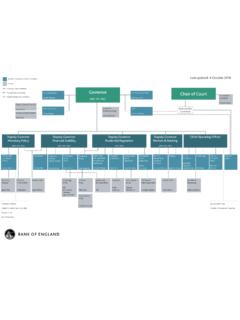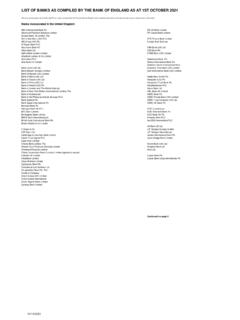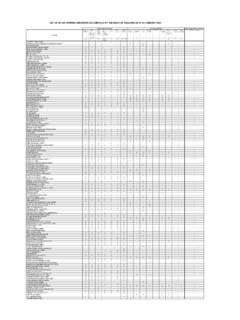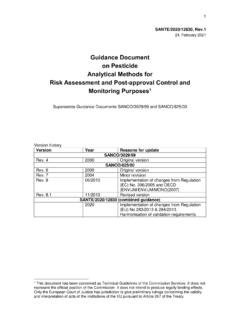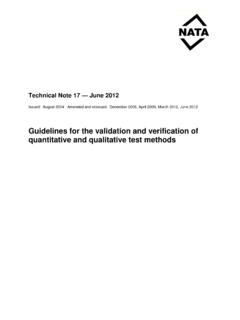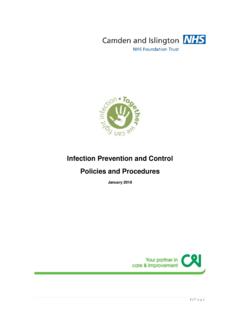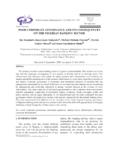Transcription of Financial Policy Summary and Record of the Financial ...
1 Financial Policy Summary and Record of the Financial Policy Committee Meetings on 29 November and 9 December 2021 Publication date: 13 December 2021 This is the Record of the Financial Policy Committee meetings held on 29 November and 9 December 2021. It is also available on the Internet: The Financial Policy Committee (FPC) was established under the Bank of England Act 1998, through amendments made in the Financial Services Act 2012. The legislation establishing the FPC came into force on 1 April 2013. The objectives of the Committee are to exercise its functions with a view to contributing to the achievement by the Bank of England of its Financial Stability Objective and, subject to that, supporting the economic Policy of Her Majesty s Government, including its objectives for growth and employment. The responsibility of the Committee, with regard to the Financial Stability Objective, relates primarily to the identification of, monitoring of, and taking of action to remove or reduce systemic risks with a view to protecting and enhancing the resilience of the UK Financial system.
2 The FPC is a committee of the Bank of England. The FPC s next Policy meeting will be on 9 March 2022 and the Record of that meeting will be published on 23 March 2022. Financial Policy Summary The Financial Policy Committee (FPC) seeks to ensure the UK Financial system is prepared for, and resilient to, the wide range of risks it could face so that the system can serve UK households and businesses in bad times as well as good. The outlook for Financial stability The UK and global economies have continued to recover from the effects of the pandemic. But uncertainty over risks to public health and the economic outlook remains. For example, there are near-term pressures on supply and inflation, and there could be a greater impact from Covid on activity, especially given uncertainties about whether new variants of the virus reduce vaccine efficacy. Bank resilience UK banks capital and liquidity positions remain strong, and they have sufficient resources to continue to support lending to the economy.
3 The FPC continues to judge that the UK banking system remains resilient to outcomes for the economy that are much more severe than the Monetary Policy Committee s (MPC s) central forecast. This judgement is supported by the final results of the 2021 solvency stress test (SST). The FPC has tested the resilience of the UK banking system against a much more severe evolution of the pandemic and consequent economic shock. In the SST, major UK banks and building societies (banks) aggregate Common Equity Tier 1 (CET1) capital ratio falls by percentage points to a low point of This low point compares with a reference rate, comprising banks minimum requirements and systemic The aggregate Tier 1 leverage ratio low point of is also above the reference rate of All eight participating banks remain above their reference rates for both CET1 capital ratios and Tier 1 leverage ratios in the exercise. As previously indicated, the aim of the SST has been to update and refine the FPC s assessment of banks resilience and their ability to lend in a very severe intensification of the macroeconomic shock arising from the pandemic.
4 Consistent with the nature of the exercise, the FPC and Prudential Regulation Committee will therefore not use the test as a direct input for setting capital buffers for UK banks. For 2022, the Bank intends to revert to the annual cyclical scenario stress-testing framework and will publish further details on this in 2022 Q1. Debt vulnerabilities The FPC remains vigilant to debt vulnerabilities in the economy that could amplify risks to Financial stability. UK household and corporate debt The FPC judges that domestic debt vulnerabilities have not increased materially over the course of the pandemic. 1 See The results of the 2021 solvency stress test of the UK banking system for further information on how the reference rate is calculated. So far, UK households finances have remained resilient as Covid-related support measures such as the furlough scheme and the ability to take a payment deferral on mortgages and consumer credit have ended.
5 Although house prices in the UK have grown in recent months at their fastest annual rate since the global Financial crisis, aggregate mortgage debt relative to income has remained broadly stable since 2009. And the share of households with a mortgage debt-servicing ratio (debt servicing costs as a proportion of income) at or above 40% a level beyond which households are typically much more likely to experience repayment difficulties remains broadly in line with 2017 19 averages and significantly below levels seen just prior to the global Financial crisis. With all other factors, such as income, held constant, mortgage interest rates would need to increase by around 150 basis points for that share to reach its pre-global Financial crisis average. UK corporate debt vulnerabilities have increased relatively moderately over the pandemic so far. As the economy has recovered and government support has been withdrawn, business insolvencies have increased somewhat, but remain below pre-Covid levels.
6 The increase in indebtedness has been moderate in aggregate, and larger corporates have repaid a significant proportion of the debt that they took on. Debt servicing remains affordable for most UK businesses. It would take large increases in borrowing costs or severe shocks to earnings to impair businesses ability to service their debt in aggregate. The increase in debt has likely led to increases in the number and scale of more vulnerable businesses. It has been concentrated in some sectors and types of businesses, in particular in small and medium-sized enterprises (SMEs). For some of these SMEs, borrowing has been precautionary. Many SMEs, however, had not previously borrowed and some would not have previously met lenders lending criteria. Most of this new bank lending is guaranteed by the Government, which will limit risks to lenders, and was issued at low interest rates and with repayment flexibility which will limit the impact on borrowers.
7 Global vulnerabilities Global debt vulnerabilities remain material. Government and central bank Policy support in advanced economies has helped to limit the size of the disruption from the pandemic. However, across advanced and emerging market economies, corporate debt to GDP ratios have generally increased, and residential property price growth in many countries has been strong. Higher leverage abroad could increase the risk of losses for UK institutions, including on their foreign exposures. Long-standing vulnerabilities in the Chinese property sector have re-emerged, against a backdrop of high and rising debt levels in China. A serious downturn in China could have a significant impact on the UK economy. While there is uncertainty as to how these risks might crystallise, the results of the 2021 SST indicate that the UK banking system is resilient to the direct effects of a severe downturn in China and Hong Kong, as well as indirect effects through sharp adjustments in global asset prices.
8 Risk-taking in global Financial markets Risk-taking in certain Financial markets remains high relative to historical levels, notwithstanding recent market volatility. Low compensation for risk in some markets could be evidence of investors search for yield behaviour, which could reflect the continued low interest rate environment and higher risk-taking. This creates a vulnerability to a sharp correction in asset prices if for example market participants re-evaluated materially the prospects for growth, inflation or interest rates that could be amplified by existing vulnerabilities in market based finance. Risks in leveraged loan markets globally continue to increase. The post-global Financial crisis trends of increased leveraged loan issuance and loosening in underwriting standards in these markets have continued. For example, the share of new lending with few Financial maintenance covenants (so-called covenant-lite lending) in these markets is at a Record high globally.
9 The UK countercyclical capital buffer rate The FPC judges that vulnerabilities that can amplify economic shocks are at a standard level overall, as was the case just before the pandemic. This would be consistent with the UK countercyclical capital buffer (CCyB) rate returning to the region of 2%. However, there continues to be uncertainty about the evolution of the pandemic and the economic outlook. Should downside risks crystallise, the economy could require more support from the Financial system. The FPC is therefore increasing the UK CCyB rate from 0% to 1%. This rate will come into effect from 13 December 2022 in line with the usual 12-month implementation period. If the UK economic recovery proceeds broadly in line with the MPC s central projections in the November Monetary Policy Report, and absent a material change in the outlook for UK Financial stability, the FPC would expect to increase the rate further to 2% in 2022 Q2.
10 That subsequent increase would be expected to take effect after the usual 12-month implementation period. The FPC s mortgage market Recommendations An excessive build-up of mortgage debt, often associated with rapid increases in house prices, has historically been an important source of risk to the UK Financial system and to the economy. The FPC therefore introduced two Recommendations in 2014 to guard against a loosening in mortgage underwriting standards, which could lead to a material increase in aggregate household debt and the number of highly indebted households: the flow limit which limits the number of mortgages that can be extended at loan to income (LTI) ratios higher than ; and the affordability test which specifies a stress interest rate for lenders when assessing prospective borrowers ability to repay a mortgage. In its latest review of the Recommendations, the FPC has concluded that these measures in aggregate continue to guard against a loosening in underwriting standards and a material increase in household indebtedness, which could amplify an economic downturn and Financial stability risks.



